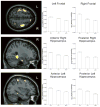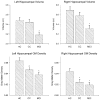Older adults with cognitive complaints show brain atrophy similar to that of amnestic MCI
- PMID: 16966547
- PMCID: PMC3488276
- DOI: 10.1212/01.wnl.0000234032.77541.a2
Older adults with cognitive complaints show brain atrophy similar to that of amnestic MCI
Abstract
Objective: To examine the neural basis of cognitive complaints in healthy older adults in the absence of memory impairment and to determine whether there are medial temporal lobe (MTL) gray matter (GM) changes as reported in Alzheimer disease (AD) and amnestic mild cognitive impairment (MCI).
Methods: Participants were 40 euthymic individuals with cognitive complaints (CCs) who had normal neuropsychological test performance. The authors compared their structural brain MRI scans to those of 40 patients with amnestic MCI and 40 healthy controls (HCs) using voxel-based morphometry and hippocampal volume analysis.
Results: The CC and MCI groups showed similar patterns of decreased GM relative to the HC group on whole brain analysis, with differences evident in the MTL, frontotemporal, and other neocortical regions. The degree of GM loss was associated with extent of both memory complaints and performance deficits. Manually segmented hippocampal volumes, adjusted for age and intracranial volume, were significantly reduced only in the MCI group, with the CC group showing an intermediate level.
Conclusions: Cognitive complaints in older adults may indicate underlying neurodegenerative changes even when unaccompanied by deficits on formal testing. The cognitive complaint group may represent a pre-mild cognitive impairment stage and may provide an earlier therapeutic opportunity than mild cognitive impairment. MRI analysis approaches incorporating signal intensity may have greater sensitivity in early preclinical stages than volumetric methods.
Conflict of interest statement
Disclosure: The authors report no conflicts of interest.
Figures





References
-
- Petersen RC, Doody R, Kurz A, et al. Current concepts in mild cognitive impairment. Arch Neurol. 2001;58:1985–1992. - PubMed
-
- Petersen RC, Stevens JC, Ganguli M, Tangalos EG, Cummings JL, DeKosky ST. Practice parameter: early detection of dementia: mild cognitive impairment (an evidence-based review). Report of the quality standards subcommittee of the American Academy of Neurology. Neurology. 2001;56:1133–1142. - PubMed
-
- Bischkopf J, Busse A, Angermeyer MC. Mild cognitive impairment—a review of prevalence, incidence and outcome according to current approaches. Acta Psychiatr Scand. 2002;106:403–414. - PubMed
-
- Jonker C, Geerlings MI, Schmand B. Are memory complaints predictive for dementia? A review of clinical and population-based studies. Int J Geriatr Psychiatry. 2000;15:983–991. - PubMed
-
- Taylor JL, Miller TP, Tinklenberg JR. Correlates of memory decline: a 4-year longitudinal study of older adults with memory complaints. Psychol Aging. 1992;7:185–193. - PubMed
Publication types
MeSH terms
Grants and funding
LinkOut - more resources
Full Text Sources
Medical
